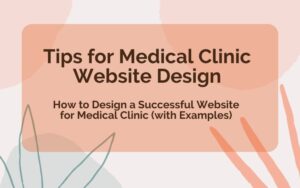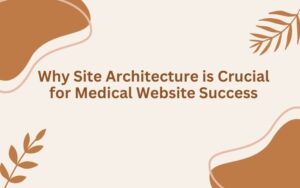Do you have a website for your medical practice but it’s struggling to attract new patients?
Outdated designs and poor functionality can harm your practice. Patients want easy online appointment booking and health information access. Don’t fall behind competitors. This guide covers key features for medical websites, helping you improve patient engagement and grow your practice.
1. Clear Navigation and User-Friendly Design
When designing a medical website, prioritizing clear navigation and a user-friendly design is fundamental. Visitors seeking health-related information or services must be able to easily locate the necessary details without confusion.
To ensure clear navigation, the website’s menu should be well-organized with sections such as offered services, medical professionals, patient resources, appointment scheduling, and contact information. This menu should be prominently displayed and consistent across all pages to facilitate a smooth browsing experience for users.
A user-friendly design plays a vital role in enabling visitors to access information effortlessly. A neat and uncluttered layout, easily readable typography, and adequate spacing enhance readability. It is important for the website to be mobile-friendly as well, adapting seamlessly to different device screens for a consistent browsing experience.
2. Responsive Design
Responsive design is a crucial element when creating a medical website to ensure that the site is accessible and functional across various devices.
With an increasing number of users accessing websites through smartphones and tablets, it is imperative that the website adapts seamlessly to different screen sizes.
By implementing responsive design, medical websites can provide a user-friendly experience regardless of the device being used. This allows visitors to access information efficiently and navigate the site with ease, ensuring a great user experience regardless of what devices they’re using.
3. Easy Appointment Scheduling
Online appointment scheduling simplifies booking processes for businesses and customers alike. This feature allows visitors to book services or consultations directly through your website, eliminating the need for phone calls or emails.
By integrating a user-friendly appointment feature medical websites can offer a seamless booking experience for patients to scheduling.
The app should be easy to use and it should allow patients to select preferred dates and times, specify the type of appointment, and provide any necessary information.
Finally, the website should provide instant confirmation of the booked appointment, along with relevant details and appointment reminders.
4. Patient Portal for Secure Access to Health Information
Patient portals provide a secure online platform for individuals to access their personal health information. These portals serve as a vital link between patients and healthcare providers. They offer a range of features. They allow patients to view their medical records, including test results, diagnoses, and treatment plans. Patient portal should also offer patients a way to manage appointments, communicate securely with healthcare providers, request prescription refills, and pay medical bills. The benefits of patient portals are numerous, including improved patient engagement and time savings for both patients and providers.
To implement an effective patient portal, healthcare providers should focus on using strong encryption and designing an intuitive interface.
By implementing a comprehensive patient portal, healthcare providers can significantly improve patient satisfaction and streamline administrative tasks.
5. Patient Resources and Educational Information
Medical websites can help patients by offering health-related information and resources. Through regularly updated blogs and informative articles, healthcare providers can share expert knowledge on various medical conditions, treatments, and preventive care measures.
This content helps patients better understand their health issues and make informed decisions about their care. By covering topics ranging from common illnesses to complex medical procedures, these resources empower patients with knowledge and support their healthcare journey.
Additionally, well-crafted educational content can address frequently asked questions, reducing the need for repeated explanations during appointments and allowing healthcare professionals to focus on more personalized care.
6. Patient Testimonials and Reviews
Incorporating patient testimonials and reviews on your medical practice website builds trust and credibility with potential patients.
These firsthand reviews provide social proof and showcase quality of care and patient experiences at your healthcare facility. By showing these testimonials, you can highlight various aspects of your services, from the expertise of your medical staff to the comfort of your facilities.
Encourage patients to leave reviews on your website or popular healthcare review platforms, and feature selected testimonials prominently on your homepage or dedicated testimonial page.
Remember to obtain proper consent before publishing any patient feedback and ensure compliance with privacy regulations.
7. HIPAA Compliance and Security
Medical websites must prioritize patient data protection through strict HIPAA compliance measures. This includes implementing robust encryption methods for all data transmissions and secure protocols to safeguard sensitive health information.
Regular staff training on HIPAA regulations and best practices for handling patient data is essential. Conducting frequent security audits and vulnerability assessments helps identify and address potential risks promptly.
By maintaining high standards of data protection, medical websites can ensure patient trust and confidentiality while meeting legal requirements for handling personal health information.
8. Telemedicine Features
Telemedicine features on medical websites allow patients to receive care remotely, expanding access to healthcare services. Through secure video consultations, patients can connect with healthcare providers from the comfort of their homes. This technology supports various medical needs, including follow-up appointments, minor ailment diagnoses, and chronic condition management.
Telemedicine platforms often integrate with electronic health records, enabling providers to access patient information during virtual visits.
By offering telemedicine options, healthcare organizations can reduce wait times, minimize travel for patients, and provide care to those in remote areas.
9. Overview of Medical Services You Offer
A clear, comprehensive list of medical services is vital for any healthcare website. This section should outline the range of care provided, from primary services to specialized treatments.
Include details on departments such as cardiology, pediatrics, and oncology. Highlight diagnostic capabilities, surgical procedures, and preventive care programs.
Mention any unique or advanced treatments that set your facility apart. Keep the information concise yet informative, using bullet points or short paragraphs for easy scanning.
This overview helps potential patients quickly understand the scope of care available and aids in their decision-making process when choosing a healthcare provider.
10. Online Forms and Pre-Appointment Checklists
Medical websites benefit greatly from including online forms and pre-appointment checklists. These digital tools streamline the patient intake process, reducing wait times and improving efficiency.
Online forms allow patients to provide their medical history, insurance information, and reason for visit before they arrive at the clinic.
Pre-appointment checklists help patients prepare for their visits, ensuring they bring necessary documents or complete required tests beforehand. This feature not only saves time for both patients and staff but also improves the accuracy of collected information.
11. Accessibility Features
Medical websites should prioritize accessibility to ensure all users can access vital health information. Key features include proper heading structure for easy navigation with screen readers, alt text for images to describe visual content, and keyboard navigation support for those unable to use a mouse.
Color contrast should meet WCAG standards to aid users with visual impairments. Websites should offer text resizing options and be compatible with various assistive technologies.
Providing transcripts for audio content and captions for videos helps users with hearing impairments. These accessibility features not only comply with legal requirements but also demonstrate a commitment to inclusive healthcare services.
12. Clearly Visible Contact Information, Location and Business Hours
Healthcare websites should prominently display contact details, location information, and operating hours. Place this crucial information in an easy-to-find area, such as the header or footer of every page.
Include a phone number for appointments and emergencies, an email address for general inquiries, and a physical address with a map for easy navigation.
Clearly state business hours, including any variations for different departments or services. For multi-location practices, provide separate contact details for each site. Consider adding a simple contact form for patient inquiries.
This readily available information helps patients quickly connect with your practice and improves overall accessibility of your healthcare services.
13. About Us Section with Detailed Staff Bios
An informative “About Us” page builds trust and personalizes your medical practice. Start with a brief history of your facility and its mission statement.
Highlight your team’s expertise and commitment to patient care. Include detailed staff bios featuring professional headshots, qualifications, specialties, and any notable achievements.
For each healthcare provider, mention their education, certifications, years of experience, and areas of expertise. Consider adding a personal touch by including their approach to patient care or a brief statement about their passion for healthcare. This section helps patients feel more connected to your team and confident in the care they’ll receive.
Bonus Features
While essential elements form the foundation of a medical website, incorporating additional features can significantly improve user experience and set your practice apart. These bonus features go beyond the basics to provide extra value, convenience, and engagement for your patients. By implementing some of these enhancements, you can create a more comprehensive and user-friendly online presence that meets the evolving needs of healthcare consumers.
14. Patient Feedback Form or Survey
Incorporating a patient feedback form or survey on your medical website encourages continuous improvement of your services. Design a user-friendly form that allows patients to rate various aspects of their experience, such as wait times, staff courtesy, and quality of care. Include open-ended questions for detailed feedback on specific areas of improvement. Make the form easily accessible from multiple pages on your site. Consider offering an incentive, like entry into a monthly draw, to boost participation rates. Regularly review and act on the feedback received to demonstrate your commitment to patient satisfaction and quality healthcare delivery.
15. Special Offers or Health Promotions
Featuring special offers or health promotions on your medical website can attract new patients and encourage existing ones to engage with additional services. Create a dedicated section to showcase seasonal health screenings, discounted preventive care packages, or limited-time offers on specific treatments. Highlight the value and benefits of each promotion, clearly stating eligibility criteria and expiration dates. Consider offering bundled services or loyalty programs to incentivize repeat visits. Ensure all promotions align with ethical guidelines and regulations in healthcare advertising. Regularly update this section to keep content fresh and relevant to current health trends or seasons.
16. Multilingual Support
Offering multi-lingual support on your medical website ensures accessibility for diverse patient populations. Implement a language selection feature that allows users to switch between different languages easily. Translate key medical information, service descriptions, and patient resources into the most common languages spoken in your community. Use professional translation services to ensure accuracy, especially for medical terminology.
Consider adding a real-time translation feature for dynamic content like blog posts or news updates. Providing multi-lingual support not only improves patient understanding and engagement but also demonstrates your commitment to inclusive healthcare services.
17. Interactive Health Assessment Quizzes
Incorporating interactive health assessment quizzes on your medical website engages visitors while providing valuable health insights. These quizzes can cover various topics such as heart health, diabetes risk, or mental wellness. Design user-friendly questionnaires with clear, concise questions and multiple-choice answers for easy completion. After submission, provide personalized results with general health recommendations and suggestions for follow-up care if needed. Include disclaimers stating that these assessments are not substitutes for professional medical advice. These quizzes not only educate patients about potential health risks but also encourage them to seek appropriate medical care when necessary.
18. Downloadable Health and Wellness E-Guides
Offer a library of downloadable health and wellness e-guides on your medical website to provide additional value to visitors. Create comprehensive guides on various health topics, such as nutrition, exercise, stress management, or disease prevention. Ensure these e-guides are well-designed, easy to read, and contain accurate, up-to-date medical information. Make them available in PDF format for easy downloading and printing. Consider requiring email sign-up for access, which can help build your patient database for future communications. Regularly update and expand your e-guide collection to keep content fresh and relevant to current health trends and patient interests.
Conclusion
Essential medical website features encompass a wide range of elements designed to enhance patient experience, streamline healthcare processes, and provide valuable information. These features include easy appointment scheduling, patient portals for secure access to health information, comprehensive overviews of medical services, accessibility features, clearly visible contact information, detailed staff bios, and HIPAA compliance measures. Additional enhancements like telemedicine capabilities, online forms, patient testimonials, and educational resources further improve the website’s functionality and user engagement.






